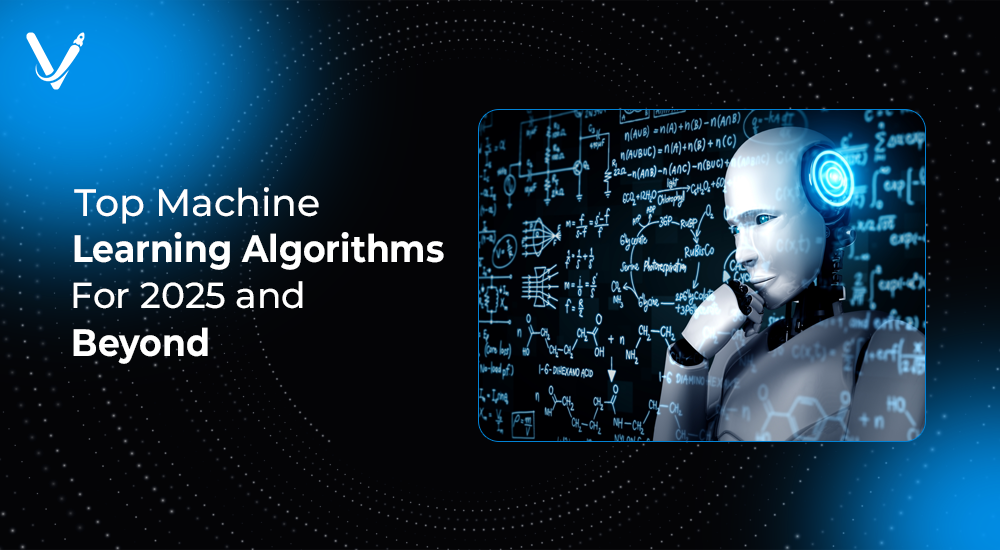Top Machine Learning Algorithms for 2025 and Beyond


- Jun 7, 2025
Machine learning (ML) continues to reshape every major industry—automating tasks, discovering insights, and unlocking new revenue opportunities. As we move into 2025, the ML landscape is maturing rapidly with breakthroughs in both foundational algorithms and application-specific models.
Whether you're building intelligent mobile apps, predictive healthcare systems, or recommendation engines, understanding the top machine learning algorithms in 2025 and beyond is essential. This article unpacks the leading algorithms, why they matter now, and how they’re powering real-world systems across finance, healthcare, transportation, marketing, and more.
We'll also highlight what differentiates these algorithms in 2025—scalability, interpretability, resource efficiency, and readiness for production environments. If you're a developer, data scientist, CTO, or business leader looking to stay ahead, this guide will help you make informed decisions and unlock value with ML.
Before diving into the specific algorithms, it’s important to understand the environment they're being deployed in.
Let’s explore the top machine learning algorithms shaping this landsc=]\
Random Forest: The Gold Standard for Structured Data
Random Forest remains a powerhouse in 2025, especially in enterprise settings where structured tabular data is king. It’s an ensemble method that builds multiple decision trees and merges their outputs to improve accuracy and reduce overfitting.
Why It’s Still Relevant:
Use Cases:
Example: A telecom company used Random Forest to reduce churn by 23% after identifying key predictors like call drops, contract type, and billing cycles.
Gradient boosting methods like XGBoost and LightGBM continue to dominate ML competitions and production systems in 2025.
Why They’re Powerful:
Industries Benefiting:
Pro Tip: LightGBM is preferred when working with large datasets due to its speed and memory efficiency, while XGBoost is better when you need high accuracy with moderate data sizes.
CatBoost, developed by Yandex, is gaining popularity in 2025 due to its seamless handling of categorical variables without preprocessing.
Advantages:
Case Study: A real estate platform used CatBoost to predict property prices with 15% better accuracy by leveraging high-cardinality features like postal codes and amenities.
While deep learning dominates large datasets, Support Vector Machines (SVM) are still ideal for smaller datasets and high-dimensional spaces such as text classification and bioinformatics.
Why It’s Useful:
Application:
Pro Tip: In 2025, hybrid SVMs are often used with kernel tricks and dimensionality reduction to boost performance.
Despite being a basic algorithm, KNN continues to find relevance in 2025 in cases where explainability and minimal training time are key.
Strengths:
Real-World Example: Retailers use KNN to build personalized shopping experiences by comparing new users to their nearest behavioral neighbors.
When speed and simplicity are paramount, Naive Bayes delivers. It’s especially potent for natural language processing (NLP) and real-time classification tasks.
Benefits:
In Action: News aggregators and spam filters still rely on Naive Bayes for its ability to learn from streams of new content without retraining from scratch.
By 2025, Deep Neural Networks (DNNs) are omnipresent. These models excel at learning hierarchical representations of data and power everything from language models to computer vision.
Key Advancements:
Use Cases:
The Transformer architecture revolutionized ML, and in 2025, it’s not just powering ChatGPT but also tools in code generation, drug discovery, and creative industries.
Popular Variants:
Why They’re Top-Tier:
Impact Example: Legal tech firms are using transformers to automate document analysis, reducing review time by over 60%.
In domains where relationships and structures matter, GNNs are shining in 2025. These algorithms model entities (nodes) and their relationships (edges).
Great For:
Industry Use Case: Drug discovery startups use GNNs to predict how different molecules interact, significantly cutting down time for new treatment development.
Reinforcement Learning (RL) has transcended gaming and is now embedded in business automation, robotics, and operations research.
Emerging Applications:
Example: Supply chain platforms are using RL to continuously learn and optimize inventory replenishment strategies.
By 2025, AutoML frameworks like Google AutoML, H2O.ai, and Auto-sklearn have enabled non-experts to build state-of-the-art models with minimal code.
Core Benefits:
Insight: Companies with lean ML teams now use AutoML to iterate fast and validate business ideas without extensive data science overhead.
With data privacy laws like GDPR and India’s DPDP Act in effect, Federated Learning is a top contender for healthcare, finance, and education systems.
Why It’s Game-Changing:
Example: Hospitals collaboratively train diagnostic models on patient scans without sharing any actual data, maintaining full compliance.
The “best” machine learning algorithm depends on your specific use case, available data, desired interpretability, and computational resources.
Considerations When Choosing:
As we navigate 2025 and beyond, machine learning is no longer a luxury—it’s a necessity. The competitive edge lies in choosing the right algorithm, adapting quickly, and building systems that are interpretable, scalable, and secure.
By mastering these top algorithms, businesses and developers can stay ahead in a rapidly evolving digital ecosystem. Whether you're building smart apps, predicting trends, or automating decisions, these tools offer the foundation for innovation.
Need help implementing cutting-edge ML algorithms for your business?
Connect with Vasundhara Infotech—your trusted partner in building smart, AI-powered solutions that drive growth, efficiency, and value.
Copyright © 2025 Vasundhara Infotech. All Rights Reserved.
